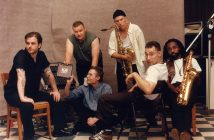Released as both a reissue of Lady Gaga’s debut album The Fame as well as just a standalone EP in some territories around the world, The Fame Monster was met with global commercial and critical acclaim and is arguably Gaga’s most successful endeavour to date. Throbbing with a dark, rough undertone, the album was important in the evolution of the pop icon, consisting of some of Gaga’s biggest hits, most known videos and supported by her most elaborate and haunting visuals. Combined with The Fame, The Fame Monster sold over 15 million copies worldwide and continues to be one of the biggest selling albums of the 21st century, as well as being nominated for a total of six Grammy Awards and winning Best Pop Vocal Album. Spawning two UK number one singles out of the four singles released from the album, the album will forever be seen as a staple of contemporary pop music.
Following from the successful singles ‘Just Dance’, ‘Poker Face’, ‘LoveGame’ and ‘Paparazzi’, released over the years of 2008 and 2009, the lead single from The Fame Monster, ‘Bad Romance’, took the world by storm. Accompanied by one of the most-watched videos on YouTube (and remains to be the case this day despite being released over six years ago), ‘Bad Romance’ adapted the electronic, vibrant and uber-pop characteristics that preceded it and showcased a darker side to Lady Gaga. Lasting nearly five minutes, the track has masterful lyrics that range from Hitchcock references to the chants of “rah, rah” and “Gaga” that continue to remain prevalent amongst live audiences at Gaga concerts today. The track’s accompanied dance also continues its influence today, where Gaga’s iconic claw is still used in her performances whilst her nickname ‘Mother Monster’ also sustains.
Other singles include ‘Alejandro’, which combines the delicate sound of the violin with a strong dance beat. The melancholic darkness that echoes the song is evocative of the sadness that characterises a lot of the tracks on the album, perfectly symbolising the monster within fame that Lady Gaga wanted to explore following from the overtly upbeat ‘Just Dance’ and ‘Money Honey’ of The Fame. Gaga’s collaboration with Beyoncé was another worldwide hit, with ‘Telephone’ likely to be Gaga’s most epic and important video of her career. Although Gaga refers to the song as her least favourite song because of the memories it provokes – as well as the track evidently consisting of very simplistic lyrics in comparison to the sophisticated songs we hear elsewhere on the album – ‘Telephone’ was still pivotal in Gaga’s career.
Other standout tracks on the album is the piano ballad ‘Speechless’, which was famously performed at the Royal Variety Show when Gaga met the Queen. Consisting of lyrics such as “your cigarette stained lies” and “you popped my heart seams”, the track is the most emotive of them all and showcases Gaga’s exceptional vocals which, before then, wasn’t as clear as it is today. ‘Teeth’ also stands out amongst the eight tracks, unveiling another sound to Gaga’s chameleon-like nature, straying from the electronic reverberations to a fusion of an almost jazzy evocation and a more traditional pop sound.
Following on from The Fame Monster, Lady Gaga created the confident, Grammy-winning, number one album Born This Way in 2011, followed by releasing the explosive ARTPOP in 2013 before her jazz collaboration with Tony Bennett with the number one and Grammy-winning album, Cheek to Cheek, last year. Rumoured to be working with RedOne as well as important figures in the disco industry, the direction of Gaga’s upcoming album (rumoured to be in 2016) may go full circle. Regardless where Gaga goes next, The Fame Monster will remain to be an important project in Gaga’s developing career as one of the most important women in music and popular culture.
The Fame Monster was released on November 18 2009 via Interscope Records.

![Midge Ure on Legacy, Live Aid, and his upcoming ‘Catalogue’ tour: ‘The idea that there could be an [AI] Ultravox in 40/50 years from now is terrifying’](https://theedgesusu.co.uk/wp-content/uploads/2024/03/download-214x140.jpg)

